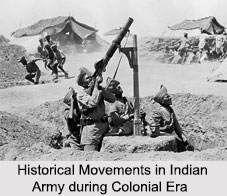 Historical Movements in Indian Army during Colonial Era still looms large amongst people in India. British colonial rule in India had been established through a series of wars fought across the subcontinent from the mid of 18th century onwards. It becomes clear that the period of history is inevitably bound up with the history of the independence movement.
Historical Movements in Indian Army during Colonial Era still looms large amongst people in India. British colonial rule in India had been established through a series of wars fought across the subcontinent from the mid of 18th century onwards. It becomes clear that the period of history is inevitably bound up with the history of the independence movement.
The First World War had lasting consequences that extended far beyond Europe. It set in motion forces that developed into India"s independence movement. The First World War was a global conflict which involved many Commonwealth countries that made huge sacrifices.
Role of Indian Army in First World War
India made a huge contribution to Britain"s war effort. A staggering numbers of volunteers were sent to fight and die on behalf of the allied forces. Almost 1.5 million Muslim, Sikh and Hindu men from regions such as the Punjab, Uttar Pradesh, Maharashtra, Tamil Nadu and Bihar volunteered in the Indian Expeditionary Force. They saw fighting on the Western Front, in East Africa, Mesopotamia, Egypt and Gallipoli. However, of these men, around 50,000 died, 65,000 were wounded, and 10,000 were reported missing, while 98 Indian Army nurses were killed. The country also supplied 170,000 animals, 3.7 million tonnes of jute supplies for sandbags and a huge loan to the British government.
It is a fact that India was heavily involved in the First World War as a key contributor to the allied forces and at that time an important part of the British Empire. Having made huge sacrifices and demonstrated military valour equal to that of European soldiers, Indians widely expected a transition to self-government. Following this period, Mahatma Gandhi launched his first nationwide campaign of Civil Disobedience against British authority in 1919. Thus, the origins of Indian independence can be traced back to the events of the First World War.
Thus, it is a shining example of people from different castes, creeds, races, communities and faiths coming together against the exploitation and discrimination. It is indeed remarkable that the movement was the fact that it is a saga of sacrifices, unending patience and remarkable unity among groups.




















